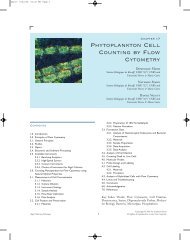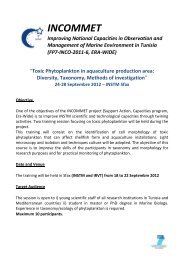Eukaryotic Picoplankton in Surface Oceans - incommet
Eukaryotic Picoplankton in Surface Oceans - incommet
Eukaryotic Picoplankton in Surface Oceans - incommet
Create successful ePaper yourself
Turn your PDF publications into a flip-book with our unique Google optimized e-Paper software.
Annu. Rev. Microbiol. 2011.65:91-110. Downloaded from www.annualreviews.org<br />
by CSIC - Consejo Superior de Investigaciones Cientificas on 09/27/11. For personal use only.<br />
positive trends of PPE with Chl a (47) and less<br />
clear positive trends between HPE and bacteria<br />
(29). In general, it seems that resource control<br />
on microbial eukaryotes is more common<br />
<strong>in</strong> oligotrophic systems and predation control is<br />
more common <strong>in</strong> productive systems. Bottomup<br />
and top-down forces operate on <strong>in</strong>dividuals<br />
and populations, so <strong>in</strong>tr<strong>in</strong>sic specific differences<br />
<strong>in</strong> resource acquisition and predation-viral susceptibility<br />
may affect the f<strong>in</strong>al observed trends.<br />
Contribution to Primary Production<br />
and Bacterivory<br />
Picoeukaryotes are clearly the most abundant<br />
eukaryotes <strong>in</strong> the sea, but this does not directly<br />
imply a large biogeochemical impact.<br />
PPE cells are primary producers that use CO 2 ,<br />
<strong>in</strong>organic nutrients, and light for growth. Together<br />
with Prochlorococcus and Synechococcus<br />
they form the picophytoplankton, which accounts<br />
for a high fraction (80%–90%) of phytoplankton<br />
biomass <strong>in</strong> the open sea (42, 60)<br />
and ∼10% <strong>in</strong> the most productive systems<br />
(2). The dom<strong>in</strong>ance of picophytoplankton <strong>in</strong><br />
nutrient-poor systems reflects its advantages <strong>in</strong><br />
resource and light acquisition with respect to<br />
larger cells (66). With<strong>in</strong> the picophytoplankton,<br />
PPE cells, slightly larger than cyanobacteria,<br />
typically dom<strong>in</strong>ate (60%–80%) biomass and<br />
primary production (46, 87). Therefore, PPE<br />
cells appear as important contributors of algal<br />
biomass and primary production globally. For<br />
<strong>in</strong>stance, they account for 38%–50% of algal<br />
biomass <strong>in</strong> the Indian Ocean (60) and for 34% of<br />
primary production <strong>in</strong> the North Atlantic (36).<br />
HPE cells are generally bacterial grazers<br />
(39). Their contribution to biomass requires<br />
microscopic cell siz<strong>in</strong>g because they do not have<br />
a signature for cell fractionation. Such an exercise<br />
has been done <strong>in</strong> the Blanes Bay Microbial<br />
Observatory, yield<strong>in</strong>g a 33% contribution<br />
of HPE to the biomass of heterotrophic<br />
eukaryotes








